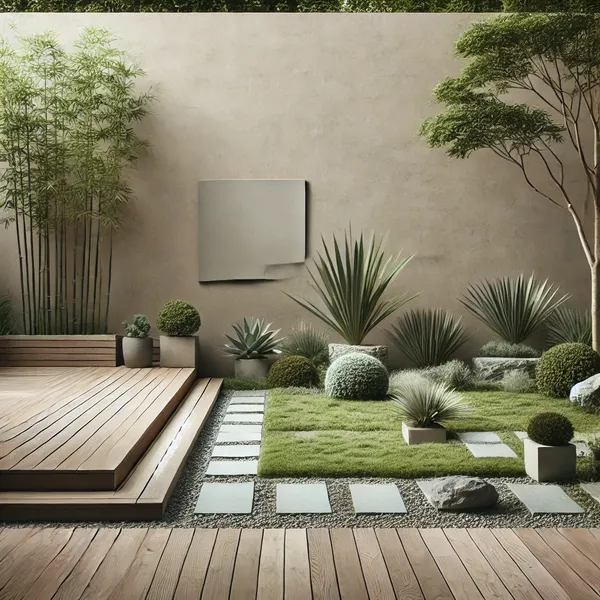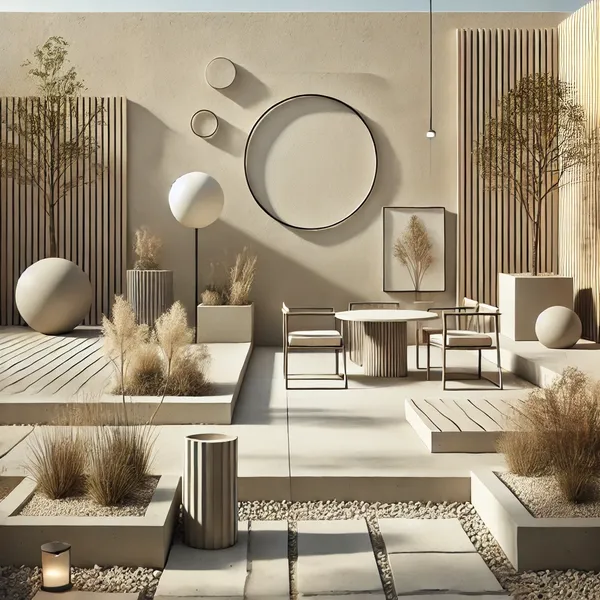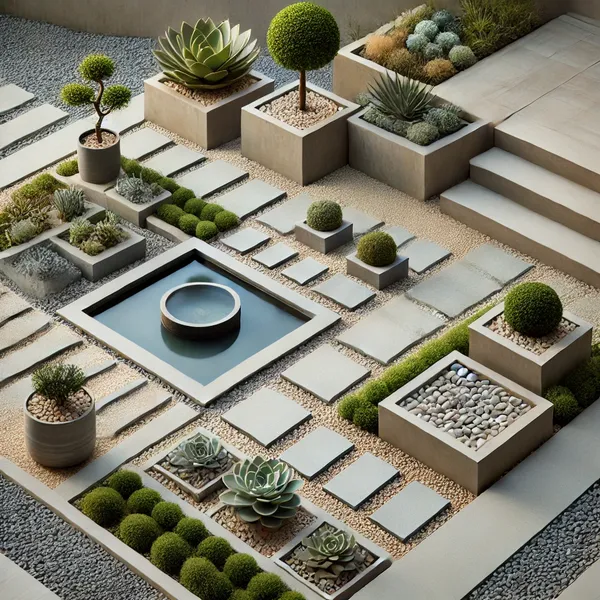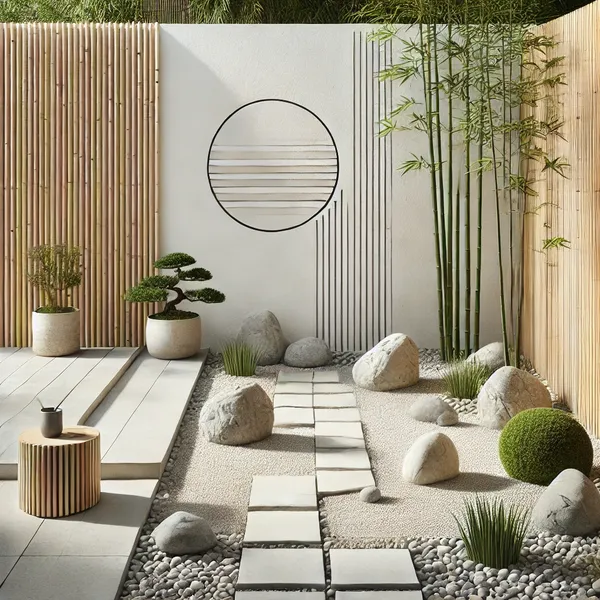A minimalist garden decor should be easily recognisable, functional, and as close to nature. To have a well-designed and pretty outdoor living area, you do not have to have a lot of costly accessories. Less can be more.
Therefore, the simplicity of the interior design can be easily maintained or created right from the start, and the primary focus can be put on the elements in the garden.
This guide will look at implementing minimalist ideas into garden design and learn how to create a simple, uncluttered garden.
We will also provide simple strategies and suggestions for creating a minimalist garden.
What does it mean to have minimalist garden decor?

Simplicity is the primary tag that defines minimalist objects for garden decoration and furniture, functionality and appeal to nature.
It is a style aimed at minimising the use of items and the creation of additional decorations that would divert attention to anything other than the garden, which is beautiful, clean, and pleasant.
The concept is that every object placed in any particular space has a meaning or is needed for the specific interior.
Here are some fundamental principles of minimalist garden decor:
- Simplicity: Less is more. It is simple, with fewer plants and accessories, but of the best quality, some consider modern gardens.
- Clean lines: What does order look like? Adhere to straight-lined routes, geometric shapes and open spaces.
- Natural materials: Wood, Stone, Metal and Concrete are used for a neat and natural look.
- Neutral colours: SSophisticatedcolours that are naturally inspired are white, beige, grey, black, and other similar shades.
Why To Prefer Minimalist Garden Decor?

Minimalist gardens have their advantages that are unrelated to the exterior and interior appearance of the house. If you’re wondering why you should give this style a try, here are a few reasons:
Low Maintenance
Fewer plants and decorations also mean a minimalist garden is much easier to maintain. Most usual activities like pruning or weeding will take less time than in other gardens.
Clarity and Focus
The design follows the principle of simplicity and is free from unnecessary elements to convey preeminent tranquillity. And often, it doesn’t help that designers make the space too congested where we can get uncomfortable overstuffed furniture.
Timeless Appeal
It proves that simple concepts remain popular all the time. For many years, your garden will stay fascinating and contemporary.
Eco-Friendly
Since the minimalistic garden usually has a less complex design, it is easier to maintain and, therefore, more ecological.
It is time to show you how to achieve the ultimate minimalist garden. Let’s begin.
How to Create a Minimalist Garden

Creating a minimalist garden does not mean you should be a professional.
It’s about control, minimising the chaos that can enter a living space while at the same time ensuring that this space is practical and aesthetic. Follow these steps to start your minimalist garden:
1. Start with a Clear Plan
If you are about to arrange your garden or start making small changes by planting flowers and choosing appropriate furniture, colours, and accessories for your outdoor space, try to imagine the general concept for your garden. Here are some things to consider:
- Space and layout: Evaluate your garden’s shape. Do you have a small backyard, or do you have a spacious back area?
- Function: First, you or any gardening enthusiast must ask one essential question fundamental to the purpose of the garden you are creating to serve. Will it be a play area, or for parties, or a garden, a local park or a community garden? There are three areas separated from each other, and they all turn into utility spots in a minimalist garden, so think about the spatial distribution of garden elements.
- Style: Do you want to achieve the oriental-inspiring feel of the Japanese garden or the plain and elegant simplicity of a modern minimalist look, or are you more on the natural, earthy type? Refined and elegant if I had decided on formal attire, relaxed comfort if we had opted for casual looks, sure and powerful if we had opted for the business dress code.
Once the vision is clear, drawing a first and very basic fundamental. This will assist you in navigating through such choices and making sure everything is well coordinated.
2. Lift Select Easy-to-Care Species
It should be pointed out that plants assume a prominent position in a minimalist garden, but you don’t need to cram your garden with shrubs. Here are some plant ideas for minimalist gardens:
- Succulents: They love light conditions and differ in shape and size, making them excellent for minimalist layouts. The plants do not require a water supply and can adapt to many situations.
- Grasses: Small trees or shrubs such as maple, dogwood, or river birch can be complemented with ornamentally grown fescue or blue oat grasses that are not very tall.
- Bamboo: This quickly growing plant will add an aura of sophistication to the landscape and, if need be, form a screen.
- Lavender is extremely relaxing to the senses, making it the perfect addition to minimalist gardens because of its colour and fragrance.
- Cacti: These plants blend perfectly with a minimalist environment and provide an architectural look.
To define the type of plants, one should use restricted colour combinations. Regarding colour schemes, it is advisable to use a lot of green, white and any other plain shades.
Keep the number of colours the same; choose plants with relatively minor forms and structures.
3. Use Clean, Geometric Hardscaping Elements
A hardscape is a nonliving part of the garden – the patio, pathways, seats, or a swimming pool. Here are some tips for adding hardscaping to your minimalist garden:
- Paths and Walkways: They should embrace straight, simple design layout plans to guide people through the gardens. Ideal for minimalist paths – concrete, stone or gravel.
- Patios: A bare space or a plain concrete or wooden floor can become a practical terrace for sitting or eating.
- Garden Walls and Screens: Create metal, wooden or stone barriers around your garden to give your landscape a transparent partition. The vertical garden screens may also be used to divide different areas.
- Water Features: Those who want to enter the exposed area should hire an SSC, reflecting pool, or any simple fountain.
4. Focus on Simple, Stylish Furniture
Furniture is essential in any garden, but in minimalist gardening, everything about the design is done in moderation. Opt for contemporary, sleek furniture that will not overpower any available space. Here are some ideas:
- Concrete benches: It’s a set of rugged and sleek lawn benches you can always use to chill out.
- Wooden loungers: Use white chaises with a plain colour scheme for a more natural-looking design.
- Metal chairs: This type of chair can be made of metal and be spare in design; this look will bring industrial grate to the garden.
- Hanging chairs: If you’re looking for something different, a hanging chair provides style and comfort to a home without needing much space.
The idea is to choose utility-useful, overly ornate furniture. It will be best to stick to pieces that will complement the rest of the decorations within your garden.
5. Add Minimalist Decor Pieces
Since minimalist gardens do not require vast artistic features, incorporating a few right pieces should help. Here are some decor ideas:
- Simple sculptures: Go for simple, geometric sculptures created with greyish tones, preferably from stones or metals.
- Candleholders or lanterns: Placetable lamps in the form of some simple lamps or candlesticks in pastel colours will also enhance the atmosphere.
- Planters: Buy clay or concrete planters which are more suited for the plainness of the garden you intend to develop.
- Rock arrangements: Large stones or pebbles are perfect for forming accents or small compositions on the garden’s territory.
While using the decor, one should be careful not to go over the top. When decorating a garden, you only need a few furnishing items; a few artificial crafts here and there will do the trick.
6. Incorporate Natural Elements
This design of the garden should be very close to the natural environment. Harmonise your home’s natural touch with colours and textures and as furniture with natural materials such as wood, stone, and water. Here are a few ways to incorporate nature:
- Wooden decking: Such kind of wooden work provides more warmth and texture but at the same time doesn’t make the appearance of the space overly busy.
- Stone walls or features: Add natural stone where a coarse look is desired but does not have to be cartoonish.
- Gravel or sand: A gravel or sand area can prevent Texturing your garden without overcrowding.
- Water features: An ornamental fountain, a small pond, or a water bowl can make a garden look elegant and natural if appropriately placed.
It is essential to choose natural elements because they will beautify your garden and contribute to building the atmosphere of a home garden that is relaxed and free from stress.
7. Tidiness and Neatness go Together
The first and direct dictate of minimalist garden design is that the area is free of excessive products.
Beware of leaving the space with only a few plants, decorations or pieces of furniture. Concentrate on the most important thing for you, and learn to find the values in minimalism.
The garden should also be tidy, though one should ensure it does not accumulate or lacks weeds.
Someone who wants to retain the cleanliness or the minimalist outlook in the garden would require frequent maintenance.
Minimalist Garden Ideas to Inspire You

Here are some minimalist garden ideas to help inspire your design:
Zen-inspired garden
Design a calm sanctuary where the rocks are smooth, and bamboo is planted, and plant a small water fountain in the middle. Ideal pudgy plants include bonsai or grass type and must appear sculptural.
Modern geometric garden
Paths, raised beds, and planters should be squares or rectangles. You can incorporate geometric sculptures or furniture into the interior for a modern look.
Scandi-style garden
Take advantage of Nordic minimalism and use the wooden deck, white-painted flower beds and plain furniture.
Desert garden
Selection of the planting: There should be an emphasis on succulents and cacti to follow a geometric desert landscape. Walkways: gravel.
Conclusion
Gardening should not have to be a daunting task; a minimalist garden decor is perfect for a serene outdoor design. Usually, the new house owners want a beautiful garden, and to achieve this aim, there is no need to construct our buildings and use the sculptors’ skills.
For more detailed information on the permission types and subsequent procedures, please refer to this article about the application for constructing buildings and structures. As always, the idea is to keep things simple and neat and adequately space the items provided.
If you want a beautiful garden that can be maintained easily, minimalist garden decoration is the best idea. So, start with a plan, choose
your plants and materials thoughtfully, and add plants that make you feel happy and at ease in the garden. This will soon give you a beautiful and serene garden, such as the one you desire while having your desired lifestyle.